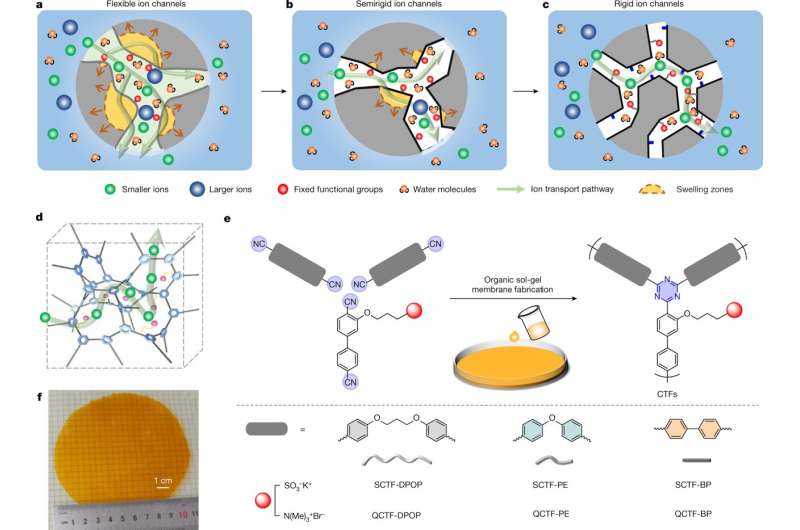This article has been reviewed according to Science X's editorial process and policies. Editors have highlighted the following attributes while ensuring the content's credibility:
fact-checked
peer-reviewed publication
trusted source
proofread
New membrane design allows selective and near-frictionless ion transport

Ion-transport membranes are vital components of clean-energy technologies, such as CO2 electrolyzers, water electrolyzers, fuel cells, redox flow batteries and ion-capture electrodialysis. These membranes must screen out specific substances to prevent crossover while efficiently conducting specific ions.
Polymer materials have the advantages of low cost, manufacturing scalability and small footprint, and thus dominate the use of ion-transport membranes in practical modules. However, the existing polymer membranes suffer from a ubiquitous "conductivity-selectivity" trade-off: highly conductive membranes tend to exhibit low selectivity and vice versa. This trade-off presents a challenge in developing membrane materials that meet the required performance criteria.
In a study published in Nature on April 26, the research team led by Professor Xu Tongwen and Professor Yang Zhengjin from the University of Science and Technology of China (USTC) of the Chinese Academy of Sciences (CAS), and their collaborators, proposed a new type of ion exchange membrane—triazine framework polymer membranes—which can break the conductivity-selectivity trade-off.
Compared to traditional materials, the triazine framework polymer membranes exhibited much enhanced capacity in both anti-swelling and anti-aging, showing an extremely low swelling ratio on water absorption. Their rigid channels ensured high selectivity from size-sieving, thus enabling extremely low permeability of active materials.
With proper control over the chemistry of rigid pore channels, the researchers observed near-frictionless ion flow within the all-rigid triazine framework polymer membrane (SCTF-BP), with the ion diffusion coefficient close to value in water. This is achieved by the robust micropore confinement within the rigid pore channels and multi-interaction between ion and membrane.
These framework membranes exhibited both extremely low permeability of active materials and ultrahigh ion diffusivity, and their advantages were exemplified as ion-conducting membranes in 2,6-dihydroxy anthraquinone / K4[Fe(CN)6] aqueous organic redox flow batteries. The membrane delivered a neat area-specific resistance as low as 0.17 Ω cm2, and thus enabled stable cell operation at extreme current densities, from 200 to 500 mA cm-2, with both high energy efficiency and high-capacity utilization.
These data related to energy efficiency and capacity utilization far surpass those for otherwise identical cells assembled with commercial membranes and state-of-the-art ion-sieving membranes.
This work highlights the importance of secondary interactions to develop high-performing ion-transport membranes. The design strategy proposed is believed to be broadly applicable, considering numerous options of organic reactions and functional monomers that can be utilized to construct polymer frameworks, and directs the fit-for-purpose design of membranes according to practical application demand.
More information: Peipei Zuo et al, Near-frictionless ion transport within triazine framework membranes, Nature (2023). DOI: 10.1038/s41586-023-05888-x
Journal information: Nature
Provided by Chinese Academy of Sciences





















